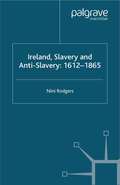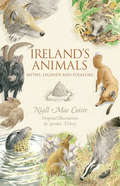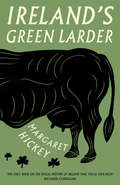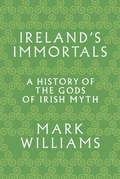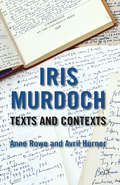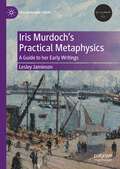- Table View
- List View
Ireland in crisis: War, politics and religion, 1641–50 (Studies in Early Modern Irish History)
by Patrick LittleThe crisis that befell Ireland in the 1640s has always fascinated historians. This volume of essays presents cutting-edge research on various aspects of the Irish wars, notably regionalism, the nature of English interventions, popular politics and the problems of allegiance, authority and legitimacy in church and state. The chapters include studies of the earl of Cork in Munster, the earl of Clanricarde in Connacht and Lord Montgomery in Ulster, as well as the Confederate Catholic engagement with popular politics. The role of the marquess of Ormond, the Irish Parliament and the Church of Ireland are also examined in new ways, and the volume ends with a fresh look at the war of words between Oliver Cromwell and the Catholic Church. Ireland in crisis presents a very different view of the period that challenges existing assumptions. It will appeal to lecturers, students and the general reader.
Ireland In Official Print Culture, 1800-1850: A New Reading Of The Poor Inquiry
by Niall Ó CiosáinThe decades after 1800 saw a fundamental redefinition of the role of the state in Ireland. Many of the most pervasive and enduring forms of official intervention and regulation date from this period, such as a permanent centralised police force, a system of elementary education, a network of small courts, and a national system of poor relief. Many of these were preceded by large-scale official investigations whose results were published as parliamentary reports, another novel aspect of state activity. The book analyses the construction and dissemination of an official image of Irish society in those reports. It takes as its principal example a state inquiry into poverty: the largest social survey of Ireland: lasting from 1833 to 1836, running to thousands of pages, and offering a unique insight into pre-famine society and official perceptions of it. This volume also illuminates two other contemporary aspects of the development of the state. The 1820s saw the beginning in Ireland of a comprehensive engagement with the parliamentary process by the population at large, with the appearance of the first mass electoral organisation in Europe, the Catholic Association. Finally, the Union of 1801 meant that Irish legislation was now discussed and enacted in Britain rather than in Ireland, and by a parliament and public newly informed by official reports on Ireland. This was therefore a crucial period in the construction of the public understanding of Ireland in both Britain and Ireland, a process in which the state and its publications played a fundamental role.
Ireland in Prehistory
by George Eogan Mr George Eogan Michael HerityThe authors examine Irish prehistory from the economic, sociological and artistic viewpoints enabling the reader to comprehend the vast amount of archaeological work accomplished in Ireland over the last twenty years.
Ireland in Prehistory
by George Eogan Mr George Eogan Michael HerityThe authors examine Irish prehistory from the economic, sociological and artistic viewpoints enabling the reader to comprehend the vast amount of archaeological work accomplished in Ireland over the last twenty years.
Ireland in the 1950s: Ireland In The 1950s
by Tom GarvinThe 1950s was a decade of international economic recovery in the United States and most of Western Europe after the disasters of World War II. There was just one exception. The Irish economy actually contracted in those years, and over four hundred thousand people, out of a population of fewer than three million, emigrated.Tom Garvin’s survey of the 1950s is based largely on a close reading of contemporary newspaper reports and analyses.This darkest decade of the Irish state was brought about by an aging government that overstayed its welcome and an ideology of rural frugality that was supported by an under-developed educational system and the overweening power of the Catholic Church.Garvin also traces the rise of the generation that broke this consensus and carried Ireland into the free-trade boom of the 1960s.
Ireland in the World: Comparative, Transnational, and Personal Perspectives (Routledge Studies in Modern History)
by Angela McCarthyThis international edited book collection of ten original contributions from established and emerging scholars explores aspects of Ireland’s place in the world since the 1780s. It imaginatively blends comparative, transnational, and personal perspectives to examine migration in a range of diverse geographical locations including Ireland, Scotland, Wales, Australia, New Zealand, the United States, Canada, Argentina, Jamaica, and the British Empire more broadly. Deploying diverse sources including letters, interviews, press reports, convict records, and social media, contributors canvas important themes such as slavery, convicts, policing, landlordism, print culture, loyalism, nationalism, sectarianism, politics, and electronic media. A range of perspectives including Catholic and Protestant, men and women, convicts and settlers are included, and the volume is accompanied by a range of striking images.
Ireland in the World: Comparative, Transnational, and Personal Perspectives (Routledge Studies in Modern History #16)
by Angela McCarthyThis international edited book collection of ten original contributions from established and emerging scholars explores aspects of Ireland’s place in the world since the 1780s. It imaginatively blends comparative, transnational, and personal perspectives to examine migration in a range of diverse geographical locations including Ireland, Scotland, Wales, Australia, New Zealand, the United States, Canada, Argentina, Jamaica, and the British Empire more broadly. Deploying diverse sources including letters, interviews, press reports, convict records, and social media, contributors canvas important themes such as slavery, convicts, policing, landlordism, print culture, loyalism, nationalism, sectarianism, politics, and electronic media. A range of perspectives including Catholic and Protestant, men and women, convicts and settlers are included, and the volume is accompanied by a range of striking images.
Ireland in the World Order: A History of Uneven Development
by Maurice CoakleyThis history examines Ireland’s development from the medieval to the modern era, comparing its unique trajectory with that of England, Scotland and Wales. *BR**BR*Maurice Coakley focuses on key elements that contributed to Ireland’s development, examining its bloody and violent incorporation into the British state, its refusal to embrace the Protestant Reformation and failure to industrialise in the 19th century. Coakley considers the crucial question of why Ireland’s national identity has come to rest on a mass movement for independence.*BR**BR*Cutting through many of the myths – imperialist and nationalist – which have obscured the real reasons for Ireland's course of development, Ireland in the World Order provides a new perspective on Irish history.
Ireland in the World Order: A History of Uneven Development
by Maurice CoakleyThis history examines Ireland’s development from the medieval to the modern era, comparing its unique trajectory with that of England, Scotland and Wales. *BR**BR*Maurice Coakley focuses on key elements that contributed to Ireland’s development, examining its bloody and violent incorporation into the British state, its refusal to embrace the Protestant Reformation and failure to industrialise in the 19th century. Coakley considers the crucial question of why Ireland’s national identity has come to rest on a mass movement for independence.*BR**BR*Cutting through many of the myths – imperialist and nationalist – which have obscured the real reasons for Ireland's course of development, Ireland in the World Order provides a new perspective on Irish history.
Ireland, Slavery and Anti-Slavery: 1612-1865
by N. RodgersThis book tackles a hitherto neglected topic by presenting Ireland as very much a part of the Black Atlantic world. It shows how slaves and sugar produced economic and political change in Eighteenth-century Ireland and discusses the role of Irish emigrants in slave societies in the Caribbean and North America.
Ireland, slavery and the Caribbean: Interdisciplinary perspectives (Studies in Imperialism #196)
by Finola O’Kane and Ciaran O’NeillIreland, slavery and the Caribbean is a complex and ground-breaking collection of essays. Grounded in history, it integrates perspectives from art historians, architectural and landscape historians, and literary scholars to produce a genuinely interdisciplinary collection that spans from 1620-1830: the high point of European colonialism. By exploring imperial, national and familial relationships from their building blocks of plantation, migration, property and trade, it finds new ways to re-create and question how slavery made the Atlantic world.
Ireland, slavery and the Caribbean: Interdisciplinary perspectives (Studies in Imperialism #196)
by Finola O'Kane Ciarán O'NeillIreland, slavery and the Caribbean is a complex and ground-breaking collection of essays. Grounded in history, it integrates perspectives from art historians, architectural and landscape historians, and literary scholars to produce a genuinely interdisciplinary collection that spans from 1620-1830: the high point of European colonialism. By exploring imperial, national and familial relationships from their building blocks of plantation, migration, property and trade, it finds new ways to re-create and question how slavery made the Atlantic world.
Ireland’s Animals: Myths, Legends And Folklore
by Niall Mac CoitirNiall Mac Coitir provides a comprehensive look at the folklore, legends and history of animals in Ireland, and describes their relations with people, being hunted for food, fur, sport, or as vermin, and their position today. A final section, inspired by stories of animal transformation, looks at twelve animals and how we can enrich our lives by visualising ourselves with their special qualities. This fascinating and beautifully illustrated compilation of folklore, legends and natural history will delight all with an interest in Ireland’s animals.
Ireland's Arctic Siege of 1947: The Big Freeze of 1947
by Professor Kevin C. KearnsOn 19 January 1947 Ireland was invaded by a freakish anticyclonic weather phenomenon unleashed from the depths of Siberia. Its prolonged two-month grip entombed the country in snow and ice.This arctic siege brought freezing temperatures of 7° Fahrenheit -14°C, a piercing east wind reaching 60-70 m.p.h., five major blizzards, and snowdrifts of 12 to 20 feet-some topping 50.Cars, buses, houses and entire villages were buried, leaving scores of passengers and inhabitants marooned. Roads were blocked, telephone and electricity lines felled and towns and farms isolated as food and fuel dwindled.Tragically this happened amidst the worst fuel crisis in Ireland's history. People were forced to strip wood from their homes, and nearly half of all Dubliners were burning furniture to survive. Severe food shortages and a virulent influenza epidemic weakened people. By 19 February 1947 Dublin's death rate had more than doubled as the poor and elderly succumbed to hunger, cold and illness.Kevin C. Kearns presents a graphic account of what was regarded as a near-biblical calamity of blizzards, freezing, hunger, floods, and threatened famine-so imperilling, wrote one newspaper, that it seemed almost as if the wrath of God was directed against Ireland.It is a vivid tale of suffering and courage, death and survival, of human resilience and real heroism, poignantly authenticated by the oral testimony of those who lived through the arctic siege.
Ireland's Great Famine and Popular Politics (Routledge Studies in Modern European History)
by Enda Delaney Breandan Mac SuibhneIreland’s Great Famine of 1845–52 was among the most devastating food crises in modern history. A country of some eight-and-a-half-million people lost one million to hunger and disease and another million to emigration. According to land activist Michael Davitt, the starving made little or no effort to assert "the animal’s right to existence," passively accepting their fate. But the poor did resist. In word and deed, they defied landlords, merchants and agents of the state: they rioted for food, opposed rent and rate collection, challenged the decisions of those controlling relief works, and scorned clergymen who attributed their suffering to the Almighty. The essays collected here examine the full range of resistance in the Great Famine, and illuminate how the crisis itself transformed popular politics. Contributors include distinguished scholars of modern Ireland and emerging historians and critics. This book is essential reading for students of modern Ireland, and the global history of collective action.
Ireland's Great Famine and Popular Politics (Routledge Studies in Modern European History)
by Enda Delaney Breandán Mac SuibhneIreland’s Great Famine of 1845–52 was among the most devastating food crises in modern history. A country of some eight-and-a-half-million people lost one million to hunger and disease and another million to emigration. According to land activist Michael Davitt, the starving made little or no effort to assert "the animal’s right to existence," passively accepting their fate. But the poor did resist. In word and deed, they defied landlords, merchants and agents of the state: they rioted for food, opposed rent and rate collection, challenged the decisions of those controlling relief works, and scorned clergymen who attributed their suffering to the Almighty. The essays collected here examine the full range of resistance in the Great Famine, and illuminate how the crisis itself transformed popular politics. Contributors include distinguished scholars of modern Ireland and emerging historians and critics. This book is essential reading for students of modern Ireland, and the global history of collective action.
Ireland’s Green Larder: The story of food and drink in Ireland
by Margaret HickeyIreland’s Green Larder tells the story of food and drink in Ireland, for the first time. From the ancient system of the Céide Fields, established a thousand years before the Pyramids were built, right up to today’s thriving food scene.Rather than focusing on battles and rulers, Margaret Hickey digs down to what has formed the day-to-day life of the people. It’s a glorious ramble through the centuries, drawing on diaries, letters, legal texts, ballads, government records, folklore and more. The story of how Queen Maeve died after being hit by a piece of hard cheese sits alongside a contemporary interview with one of Ireland’s magnificent cheese makers, and the tale of the author’s day in Clew Bay on the wild Atlantic coast, collecting the world’s freshest oysters, is countered by Jonathan Swift’s complaint about dubiously fresh salmon being sold on the streets of Dublin.Beautifully illustrated and dotted with recipes, there are chapters covering everything from strong tea to the Irish rituals and superstitions associated with food and drink. With a light touch and a flair for finding the most telling details, Hickey draws on years of research to bring this sweeping history brilliantly to life.
Ireland's Heritages: Critical Perspectives on Memory and Identity (Heritage, Culture and Identity)
by Mark McCarthyThis book is the first sustained attempt to incorporate critical scholarship and thought at the cutting edge of contemporary geography, history and archaeology into the burgeoning field of Irish heritage studies. It seeks to illustrate the validity of multiple depictions of the Irish past, showing how scrutiny of heritage practices and meanings is so essential for illuminating our understanding of the present. Examining Ireland's heritages from a critical perspective that celebrates notions of heterogeneity and uniqueness, the distinguished contributors to this book scrutinise the multiplicity of complex relations between heritage, history, memory, commemoration, economy, and cultural identity within various historical, geographical and archaeological contexts. Using several examples and case studies, this book raises issues not only from a uniquely Irish perspective, but also investigates the memorialisation and marketing of the Irish past in overseas locations such as the USA and Australia.
Ireland's Heritages: Critical Perspectives on Memory and Identity (Heritage, Culture and Identity)
by Mark McCarthyThis book is the first sustained attempt to incorporate critical scholarship and thought at the cutting edge of contemporary geography, history and archaeology into the burgeoning field of Irish heritage studies. It seeks to illustrate the validity of multiple depictions of the Irish past, showing how scrutiny of heritage practices and meanings is so essential for illuminating our understanding of the present. Examining Ireland's heritages from a critical perspective that celebrates notions of heterogeneity and uniqueness, the distinguished contributors to this book scrutinise the multiplicity of complex relations between heritage, history, memory, commemoration, economy, and cultural identity within various historical, geographical and archaeological contexts. Using several examples and case studies, this book raises issues not only from a uniquely Irish perspective, but also investigates the memorialisation and marketing of the Irish past in overseas locations such as the USA and Australia.
Ireland's Huguenots and Their Refuge, 1662-1745: An Unlikely Haven
by Raymond HyltonThis book explores this question and attempts to reveal precisely who these Huguenots were, what they contributed to and received from their adopted land, and why Huguenot ancestry is so respected and prized even among devout Irish Catholics. The true chronicle of Irelands Huguenots is, in opposition to the narrow misrepresentations of the past, one of extraordinary richness and variety, as befits an ethnic group whose influence permeated into every nook of Irish life and society. Here are some of the towering personalities that left such an imprint on Ireland's history, character and heritage: Henri, Earl of Galway; warrior turned financial tycoon David Digues Latouche; the scholar/librarian Elie Bouhereau; and many other greater and lesser luminaries.
Ireland's Immortals: A History of the Gods of Irish Myth
by Mark WilliamsIreland's Immortals tells the story of one of the world’s great mythologies. The first account of the gods of Irish myth to take in the whole sweep of Irish literature in both the nation’s languages, the book describes how Ireland’s pagan divinities were transformed into literary characters in the medieval Christian era—and how they were recast again during the Celtic Revival of the late nineteenth and early twentieth centuries. A lively narrative of supernatural beings and their fascinating and sometimes bizarre stories, Mark Williams’s comprehensive history traces how these gods—known as the Túatha Dé Danann—have shifted shape across the centuries, from Iron Age cult to medieval saga to today’s young-adult fiction.We meet the heroic Lug; the Morrígan, crow goddess of battle; the fire goddess Brigit, who moonlights as a Christian saint; the mist-cloaked sea god Manannán mac Lir; and the ageless fairies who inspired J.R.R. Tolkien’s immortal elves. Medieval clerics speculated that the Irish divinities might be devils, angels, or enchanters. W. B. Yeats invoked them to reimagine the national condition, while his friend George Russell beheld them in visions and understood them to be local versions of Hindu deities. The book also tells how the Scots repackaged Ireland’s divine beings as the gods of the Gael on both sides of the sea—and how Irish mythology continues to influence popular culture far beyond Ireland.An unmatched chronicle of the Irish gods, Ireland’s Immortals illuminates why these mythical beings have loomed so large in the world’s imagination for so long.
Ireland's Immortals: A History of the Gods of Irish Myth
by Mark WilliamsIreland's Immortals tells the story of one of the world’s great mythologies. The first account of the gods of Irish myth to take in the whole sweep of Irish literature in both the nation’s languages, the book describes how Ireland’s pagan divinities were transformed into literary characters in the medieval Christian era—and how they were recast again during the Celtic Revival of the late nineteenth and early twentieth centuries. A lively narrative of supernatural beings and their fascinating and sometimes bizarre stories, Mark Williams’s comprehensive history traces how these gods—known as the Túatha Dé Danann—have shifted shape across the centuries, from Iron Age cult to medieval saga to today’s young-adult fiction.We meet the heroic Lug; the Morrígan, crow goddess of battle; the fire goddess Brigit, who moonlights as a Christian saint; the mist-cloaked sea god Manannán mac Lir; and the ageless fairies who inspired J.R.R. Tolkien’s immortal elves. Medieval clerics speculated that the Irish divinities might be devils, angels, or enchanters. W. B. Yeats invoked them to reimagine the national condition, while his friend George Russell beheld them in visions and understood them to be local versions of Hindu deities. The book also tells how the Scots repackaged Ireland’s divine beings as the gods of the Gael on both sides of the sea—and how Irish mythology continues to influence popular culture far beyond Ireland.An unmatched chronicle of the Irish gods, Ireland’s Immortals illuminates why these mythical beings have loomed so large in the world’s imagination for so long.
Irgendwann muss doch mal Ruhe sein!: Institutionelles Ringen um Aufarbeitung von sexualisierter Gewalt und Machtmissbrauch an einem Institut für analytische Kinder- und Jugendlichenpsychotherapie (Sexuelle Gewalt in Kindheit und Jugend: Forschung als Beitrag zur Aufarbeitung)
by Gerhard Hackenschmied Peter Caspari Helga Dill Cornelia CaspariDas Buch liefert – erstmals im deutschsprachigen Raum – einen umfassenden wissenschaftlichen Beitrag zur Aufarbeitung sexualisierter Gewalt in einem Psychotherapieinstitut. Die qualitative Fallstudie nimmt jahrzehntelangen Machtmissbrauch und sexualisierte Gewalt durch den Leiter eines analytischen Kinder- und Jugendinstituts in den Blick. Dabei zeigt sich, dass die in diesem System verstrickten Psychotherapeut*innen zentralen Vorstellungen und Konzepten ihrer Profession nicht gerecht werden: Schweigen, Verleugnung, Rationalisierung, Abwehr von Verantwortung und Ignoranz gegenüber Betroffenen verhindern über lange Zeit die Aufdeckung der Taten und nachhaltige Formen der Aufarbeitung. Das Institutsleben wird von einer dialektischen Spannung zwischen der Notwendigkeit der Bearbeitung und dem Wunsch nach ungestörtem Funktionieren geprägt. Diese Dynamik erweist sich zugleich als Analogie zu Problembewältigungsmustern psychotherapeutischer Patient*innen. Der Fall verweist auf grundsätzliche Probleme im Bereich der Psychotherapie, die vor allem mit einem strukturellen Machtungleichgewicht und ausgeprägten Abhängigkeitsverhältnissen sowohl im Kontext der Ausbildung als auch im Behandlungssetting zu tun haben. Aus den Erkenntnissen dieser empirischen Untersuchung werden professions- und organisationsethische Überlegungen abgeleitet und – darauf basierend – konkrete Empfehlungen zur Prävention von sexualisierter Gewalt in Psychotherapieinstituten formuliert.
Iris Murdoch: Texts and Contexts
by Anne Rowe and Avril HornerUsing unpublished archive material, including correspondence and the many annotations Murdoch made to the books held in her Oxford library, this book offers fresh insights into Murdoch's work by placing it within a diversity of new contexts. It also reveals startling parallels between Murdoch's work and other literary and philosophical texts.
Iris Murdoch’s Practical Metaphysics: A Guide to her Early Writings (Iris Murdoch Today)
by Lesley JamiesonThis book explores Iris Murdoch as a philosopher who, through her distinctive methodology, exploits the advantages of having a mind on the borders of literature and politics in her early career writings (pre-The Sovereignty of Good). By focusing on a single decade of Murdoch’s early career, Jamieson tracks connections between her views on the state of literature and politics in postwar Britain and her approach to the philosophy of mind and moral philosophy. Furthermore, this close study reveals that, far from a stylistic quirk, Murdoch’s use of metaphors, analogies, and other literary devices is internal to her methodology. Finally, rather than asking what Murdoch’s views are, this work will ask “what is Murdoch trying to achieve with her writings and public lectures, and how does she go about this?” By answering the latter question, we will have a new strategy for interpreting her writings more generally. The book contributes to the growing body of scholarship focusing on Iris Murdoch’s philosophical writings, and on women in the history of analytic philosophy.







